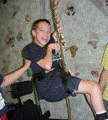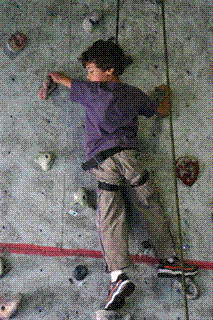Depending on the children's abilities, they may use different climbing techniques. These three techniques are commonly known as top rope techniques:
- Para Pull-Up: This technique is for children that have little or no use of their legs. The climber is
 |
| A young boy with little or no use of his legs using the Para Pull Up rock climbing technique. |
attached to a belay and an ascender, which is attached to the chest harness of the climber. A second, modified ascender with a bar fastened to it is attached to the static rope. With each pull-up on the bar, the chest ascender is moved up the static rope, raising the climber 6 inches. With this technique, the climber is generally facing the wall sideways to avoid skin abrasions on the knee.
 |
| Modified ascender with a bar fastened to it |
- Single Amputee: Single amputees use the same
 |
| Single amputees use the same technique as climbers without an amputation. |
technique as climbers without an amputation. Whether it is an upper- or lower-extremity amputation, climbers rely more on their stronger limbs to propel themselves upward. The key for a climber with an amputation is to execute each move carefully and to gain a firm grasp of the handholds and footholds on the wall.
 |
| Adult with a visual impairment is rock climbing indoors. |
- Visual Impairments: The only adaptation needed for a climber with a visual impairment is an understanding of the positions of the numbers on a non-digital clock. The climbing partner uses these numbers as audio cues to point out handholds and footholds.




